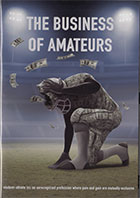
The Business of Amateurs 2016
Distributed by Tugg, Inc., 855-321-8844
Produced by Bob DeMars, Ben Edwards, and Toby Wilson
Directed by Bob DeMars
DVD , color, 89 min.
Middle School - General Adult
Sports, Brain Injuries, Business, Education, Health, Activism, Culture, Documentaries, Labor, Football, NCAA
Date Entered: 07/15/2016
Reviewed by Joseph Baumstarck, Jr., University of Louisville, Southern Baptist Theological Seminary, Ivy Tech Community CollegeIn The Business of Amateurs Bob DeMars, a former college football player from the University of Southern California, tells his story and the story of many college athletes through their own stories. Although focusing mainly on football other college sports are briefly addressed.
Beginning with an overview of how sports at the collegiate level work in the United States, the role of the National Collegiate Athletic Association (NCAA), and how college student athletes fit into the system the documentary shows how some of these athletes have fared since their glory days. In some cases, the picture is not pretty. Some of these athletes suffer from an assortment of physical, mental, relational, and economic issues which are increasingly being linked to traumatic brain injury which occurred during their sporting years.
Although the issue of brain injury has been dealt with at some length on the professional football level by the recently released Hollywood box office movie Concussion (2015) this film does not stop there. It explores the whole issue of how the collegiate sports world works including the pretense of amateurism, student athletics, and the roles of both the NCAA and the specific colleges. It is clear that although one of the original intents of the NCAA was to promote safety in sport it has become almost exclusively a way for large amounts of money to be collected and disbursed. Unfortunately, as this production makes clear almost none of this money finds its way to the athletes who are providing the labor and skills to make college sports a cultural phenomena in the United States and the world. The student athlete’s inability to capitalize on his labor is clearly demonstrated and the costs which are borne by them is clearly spelled out. Despite some scholarship assistance many athletes find themselves almost destitute while earning their colleges and the NCAA around $150,000 per athlete per year. This tremendously large amount of money, concentrated in the hands of a few colleges and the NCAA, leads to all sorts of issues including outright cheating, winning at any cost attitudes, an overemphasis on athletics and a lack of emphasis on education. Many athletes are “assisted” through the academic requirements in order to maintain eligibility for athletics, but remain unable to read effectively and often do not achieve a degree prior to the conclusion of their collegiate careers.
This film is very well done with a significant story told well and is highly recommended for all, especially those interested in sports, the education system, or simple justice. Although it does not offer much in the way of suggestions for improvement it does a good job of identifying a problem and some of the issues surrounding it. Brief sections discuss the concern that is being shown at several levels including the federal government and research centers. It is also clear that unless change is forced there is little incentive for the NCAA or the colleges to act. Organizational activities of athletes are discussed briefly and seem to be the majority of the activism documented in the film, but these activities are at an early and not very effective stage. It is clear that the money is there to provide a better system, but that those who are now profiting are not willing to share with the producers who bear the burden of this system.